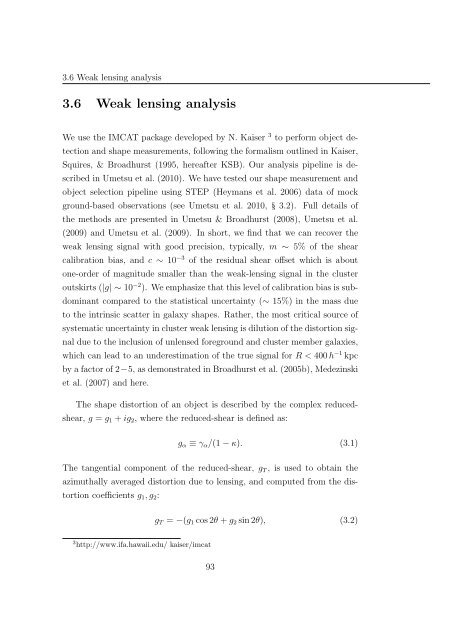Mass and Light distributions in Clusters of Galaxies - Henry A ...
Mass and Light distributions in Clusters of Galaxies - Henry A ...
Mass and Light distributions in Clusters of Galaxies - Henry A ...
Create successful ePaper yourself
Turn your PDF publications into a flip-book with our unique Google optimized e-Paper software.
3.6 Weak lens<strong>in</strong>g analysis<br />
3.6 Weak lens<strong>in</strong>g analysis<br />
We use the IMCAT package developed by N. Kaiser 3 to perform object detection<br />
<strong>and</strong> shape measurements, follow<strong>in</strong>g the formalism outl<strong>in</strong>ed <strong>in</strong> Kaiser,<br />
Squires, & Broadhurst (1995, hereafter KSB). Our analysis pipel<strong>in</strong>e is described<br />
<strong>in</strong> Umetsu et al. (2010). We have tested our shape measurement <strong>and</strong><br />
object selection pipel<strong>in</strong>e us<strong>in</strong>g STEP (Heymans et al. 2006) data <strong>of</strong> mock<br />
ground-based observations (see Umetsu et al. 2010, § 3.2). Full details <strong>of</strong><br />
the methods are presented <strong>in</strong> Umetsu & Broadhurst (2008), Umetsu et al.<br />
(2009) <strong>and</strong> Umetsu et al. (2009). In short, we f<strong>in</strong>d that we can recover the<br />
weak lens<strong>in</strong>g signal with good precision, typically, m ∼ 5% <strong>of</strong> the shear<br />
calibration bias, <strong>and</strong> c ∼ 10 −3 <strong>of</strong> the residual shear <strong>of</strong>fset which is about<br />
one-order <strong>of</strong> magnitude smaller than the weak-lens<strong>in</strong>g signal <strong>in</strong> the cluster<br />
outskirts (|g| ∼ 10 −2 ). We emphasize that this level <strong>of</strong> calibration bias is subdom<strong>in</strong>ant<br />
compared to the statistical uncerta<strong>in</strong>ty (∼ 15%) <strong>in</strong> the mass due<br />
to the <strong>in</strong>tr<strong>in</strong>sic scatter <strong>in</strong> galaxy shapes. Rather, the most critical source <strong>of</strong><br />
systematic uncerta<strong>in</strong>ty <strong>in</strong> cluster weak lens<strong>in</strong>g is dilution <strong>of</strong> the distortion signal<br />
due to the <strong>in</strong>clusion <strong>of</strong> unlensed foreground <strong>and</strong> cluster member galaxies,<br />
which can lead to an underestimation <strong>of</strong> the true signal for R < 400 h −1 kpc<br />
by a factor <strong>of</strong> 2−5, as demonstrated <strong>in</strong> Broadhurst et al. (2005b), Medez<strong>in</strong>ski<br />
et al. (2007) <strong>and</strong> here.<br />
The shape distortion <strong>of</strong> an object is described by the complex reducedshear,<br />
g = g 1 + ig 2 , where the reduced-shear is def<strong>in</strong>ed as:<br />
g α ≡ γ α /(1 − κ). (3.1)<br />
The tangential component <strong>of</strong> the reduced-shear, g T , is used to obta<strong>in</strong> the<br />
azimuthally averaged distortion due to lens<strong>in</strong>g, <strong>and</strong> computed from the distortion<br />
coefficients g 1 , g 2 :<br />
g T = −(g 1 cos 2θ + g 2 s<strong>in</strong> 2θ), (3.2)<br />
3 http://www.ifa.hawaii.edu/ kaiser/imcat<br />
93
















